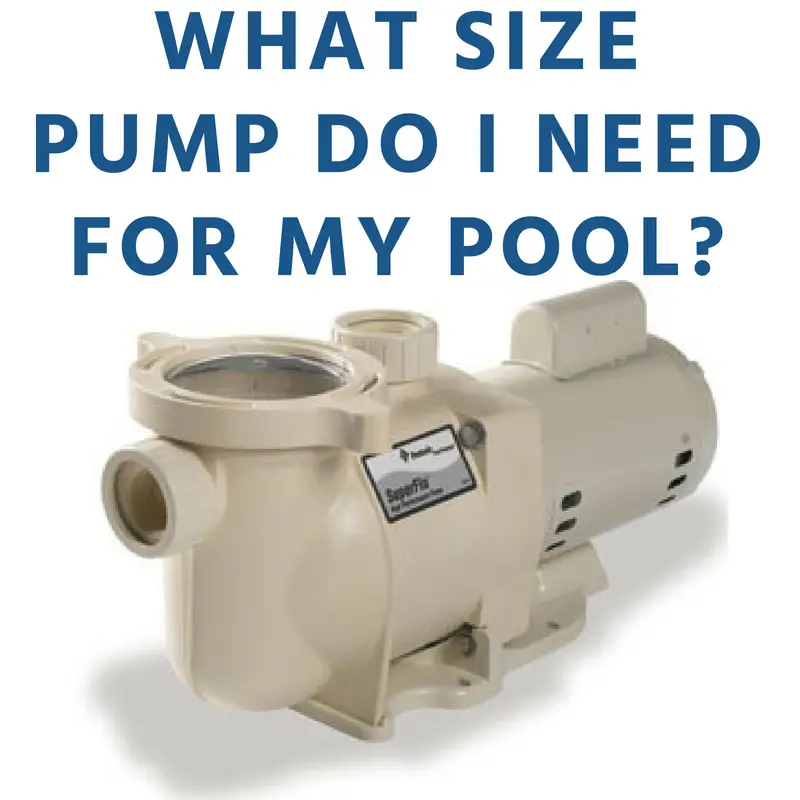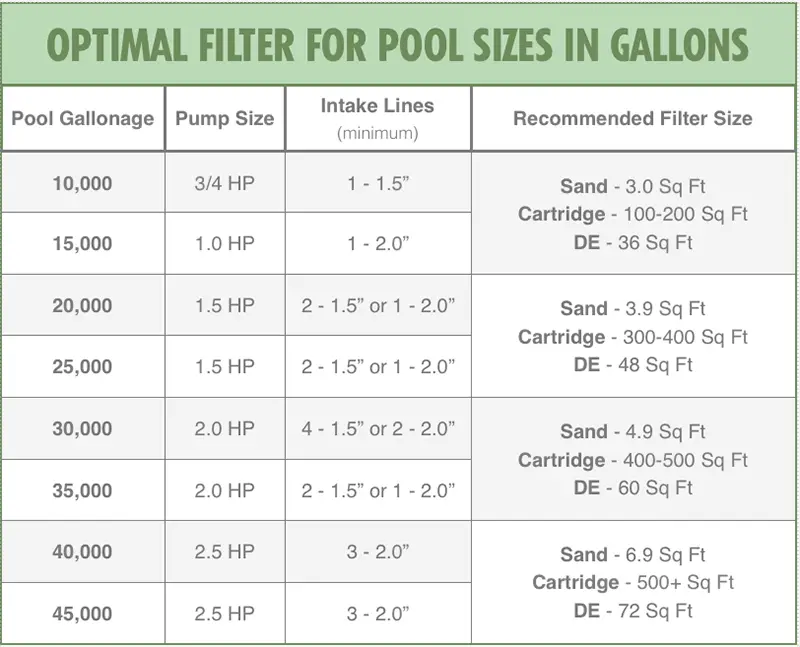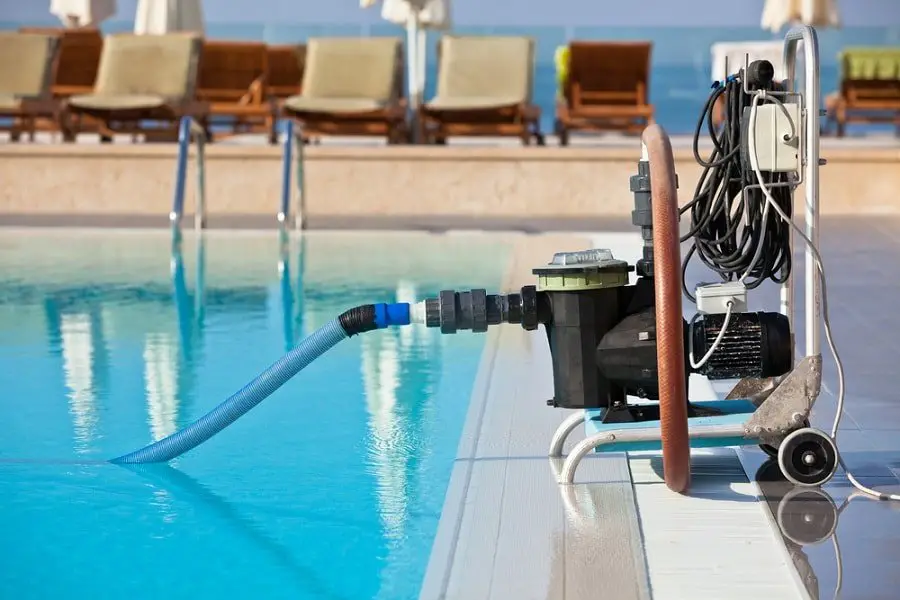How Much Electricity Does Pool Equipment Use
If you need to know the electrical requirements for your inground pool, here is a list of common pool equipment and the approximate volts and amps required for each:
- Pool Pump: 240v, 10amps
- Salt Water Chlorinator: 240v, approx 5-8 amps
- Pool Heat Pump: 240v, 50 amps
- LP/NG Pool Heater: 240v, 3 amps
- Pool Lights: 12v, 3.5 watts each
- Self-Contained Hot Tub: 240v 50 amps
- Automatic Pool Cover: 220v, 5-7 amps OR 110v, 11-13 amps
These are round numbers.
Exact figures will vary based on the specific equipment and manufacturer, so please do not just hand this list to your electrician.
Determine The Volume Of Your Pool
To determine the volume of your pool measure the surface area and then multiply that by the average depth. For example, a rectangular 3 x 5 metre pool with an average depth of 1.4 metres has a volume of 21 cubic metres. There are 1000 litres in a cubic metre, so the volume of our example pool is 21,000L.
Best Pump To Drain Pool
- EASY CLEAN with its removable intake screen for manageable maintenance.
- EASY ACCESS to pump float for cleaning requires no tools or screws.
- ERGONOMIC BUILT for portability and ease of placement and removal.
- COMPACT SIZE for stability on pool cover with 3/4″ Garden Hose Connection and a 25″ Power Cord.
- INTEGRATED FLOAT switch for reliable automatic operation and easily activates in 2″ of water.
Read Also: Salt Water Pool Calculator
What Size Of Pool Heater Do You Need
Pool heaters allow you to open your pool earlier in the spring, and extend the swimming season well into the fall, but they are a large investment, so before running out to buy a pool heater you should spend a little bit of time doing research.
If you dont choose the size of your pool heater careful you could end up spending a lot of time and money down the line.
What you need to consider
Before buying a pool heater there are five basic things that you need to determine:
- The size of your pool
- Your heating needs and preferences
- BTU requirements
- Whether or not you use a solar cover
- Environmental considerations.
1) Size of your pool
The larger your pool, the more powerful your heater will need to be, so that means you need to calculate the volume of your pool. To do this, youll have to first find the surface area and then multiply that by the average depth.
To find the surface area:
- Square and rectangular pools: simple multiply length by width
- L-shaped pools: break the pool into two rectangles and multiply length and width of each and add the two answers together
- Round pools multiply the diameter by the diameter and then multiply the answer by pi
- Oval pools multiply the longest diameter by the shortest diameter for surface area
- Kidney shaped pools add the longest width and shortest width, and multiply that by the length
For all shapes of pool:
2) Your needs and preferences
3) Know your BTUs
Pool heaters measure their power in BTU .
BTU Needed to raise temperature
Orders
What Size Heat Pump Do I Need For My Pool

The most important thing to remember when purchasing a pool water heater is to determine the correct size for your above ground pool.
Determining the pool heat pump sizing will save you money as a pool heater with the correct number of BTUs will limit the overall running time and reduce your electricity bill throughout the season. What’s more, you will reduce the overall heating time of your swimming pool heat pump during the colder months when you most want to use the heater, thereby limiting the amount of electricity required to run the unit.
Recommended Reading: Sustain Pool Chemical Dealers
Look At The Pool Pump Ratings To Find The Right Pump
Once you have decided to buy a new pump, take some time to research your options..
Don’t just assume that you need the same horsepower pump as you now have.
The sample pump chart on the right shows the pump curves for different sized pumps.
Suppose your system has 60 feet of head and you want a pump that will deliver 50 gallons per minute.
We have added a yellow line denoting 60 ft of head, and a blue line denoting 50 GPM. Find where the two lines cross and you will see the pump that will deliver the desired rate of flow.
From this chart, you can see that a 1 horsepower pump will give you 52 GPM flow on a system with 64 feet of head.
We have tried to give you the flow information on each pump so that once you come up with a rate of flow, you can come up with the proper pump, the first time.
Note: Figuring out feet of head is difficult. Typically a in-ground pool will have 50-60 feet of head pressure and an above ground pool will be somewhere around 30 feet of head. These are only approximations.
What about ‘FEET OF HEAD’ ? What does that mean?
The total resistance to flow is measured in “feet of head”. As you can tell from looking at the pump charts, the greater the resistance to flow , the lower the flow rate. The greater the resistance to flow, the more powerful the pump needs to be to overcome it.
The resistance is measured in “feet of head”. The best way is to approximate the resistance is as follows:
Start shopping for your new pool pump.
About Pool Heater Efficiency
Your swimming pool heat pumps energy efficiency is measured by COP . The higher the COP number is, the more efficient it is.
But, theres no standard test to measure this COP stuff. But theres a typical way, manufacturers measure this testing by a heat pump with an outdoor temperature of 80 degrees F as well as pool temperature of 80 degrees F.
The general range of COP is 3 to 7 and it converts to an efficiency of 300%-700%. What does it mean?
It means, for every unit of electricity it usually takes to run the compressor, you will get approximately 3-7 units of the heat out of your heat pump.
Read Also: Can You Wear Thinx In The Pool
Solar Pool Heat Pumps
The name implies a solar pump, so your pool should be in a place where there is adequate sunlight. In addition, outdoor solar pumps are more accessible to install than indoor use.
Solar heating pumps have a solar collector, filter, pump, and flow control valve. As solar energy is very cheap, its popularity is growing very fast.
Faq Draining Your Swimming Pool Water
1. Where do I drain my pool water? In Litchfield Park, where I live, the city doesnt allow draining pools into the street gutter, so I drain the water on my lawn.
2. How much water do you drain? My pool is 22,000 gallons, and I drained out about 15,000 gallons.
3. How long will it take to drain your pool water? With my 1/2 HP submersible pool pump, it took about 8 hours to drain out about 15,000 gallons at ~2000 GPH.
4. Does all that water on your lawn flood your back yard? Actually, I was surprised how quickly the water got absorbed into the ground. Never did it look like it was puddling.
5. How much did your water bill cost for refilling your pool? Last July, my water bill went up about $28.65 when I refilled my pool at .00191 cents per gallon.
That concludes this DIY tip, and now its your turn
Every pool is different, so would you share your pool water story in the comments below? It would be a great addon to this best pump to drain pool water tip.
Also, if youre a new pool owner whos just learning how to service your swimming pool, I also recommend that you check these DIY pool maintenance tools.
Don’t Miss: How To Replace Pool Tile
Calculating Your Swimming Pool Water Pump Needs
Now it’s time for a little arithmetic. Get out your calculator to figure out what you need to properly circulate your pool water and squeeze out the most efficiency. Using the example below, substitute your pool’s volume and do the math:
Remember: Pool Volume × 2 = gallons required daily for a 12-hour turn
Example:
Determine The Minimum Flow Rate
This factor calculates the minimum flow rate that must be maintained in order to circulate all the water in the pool through the filter within a certain number of hours, otherwise known as the “turnover time”.
A good turnover time for a home pool is usually 8-10 hours. A heavily used pool will need to have a shorter turnover rate. Once you know the desired turnover rate, you can determine your desired flow rate.
Use the following equation to determine the desired flow rate:
- Pool Size – number of gallons of water in the pool.
- Turnover Time – time to move entire capacity of pool through filter.
- Flow Rate – desired flow rate in gallons per minute.
| Pool Size |
|---|
| 30 GPM |
The following chart is another way to help calculate the desired flow rate.
If you have a 25,000 gallon pool and want a turnover rate of 8 hours, then you will need a pump with a flow rate of 52 gallons per minute/
If you have a 35,000 gallon pool and want a turnover rate of 10 hours, you will need a pump with a flow rate of 56 gallons per minute.
For this situation, we will use a 24,000 gallon pool with a turnover time of 8 hours, giving us a MINIMUM FLOW RATE of 50 gallons/minute.
Also Check: Aria Pools
What Size Pump Should I Get For My Pool
If you’re looking to build a new pool or simply looking to replace a pool pump you may find yourself asking, “Is a larger horsepower pool pump always better?”
PRO TIP: No matter which type of pump you choose, youll want to make sure you properly select the correct pump and filter combination. The pump needs to be sized appropriately compared to the filters flow rate. Choosing a pump with a higher flow rate than the filter will put strain on both the pump and filter, reducing life and efficiency of each. This means that you would not want to choose a pump designed to be used with 2″ plumbing piece, and then use a filter designed to be used with 1 1/2″ plumbing piece. Proper pairing of these two units is essential for a pleasant pool experience.
For example:
If choosing a pump with a 1-1/2 inlet/outlet, you should choose a filter with a 1-1/2 inlet/outlet as well. However, a pump with a 1-1/2 inlet/outlet can work with a filter with a 2 inlet/outlet if needed to.
X You would not want to attempt to use a pump with 2 inlet/outlet with a filter that has a 1-1/2 inlet/outlet as they would not be sized correctly or efficient when used together.
You can also learn more about Single Speed and Variable Speed Pumps Here!
Lets Go Deeper Into My Submersible Pump Experience

The submersible pool pump I bought drained about 15,000 of the 22,000 gallons of pool water into my back lawn in about 8 hours.
Believe me, this is not something I wanted to do, but after buying the best pool drain pump with an extra-long hose, it was pretty easy to do.
I set up the pump on Saturday afternoon, and by Sunday morning, I thought my pool was drained enough so that when I added clean water it would correct the issues. Lucky my estimate to partially drain the pool was good enough and the updated water test report was positive!
The label says the MAX flow is 2115 GPH, which worked out pretty good.
Like I said, every year for more than a decade, I hassle with trying to balance the water chemistry.
Normally it would take about 3 trips back to Leslies to get the water re-tested. Each time Id wait in line behind someone who had 50 questions.
This year, when I test my water, if its too much out of whack, Ill drain my pool again.
Besides, Id rather spend $28 on fresh clean water to swim in than on all the chemicals the Leslie Water Analysis Report says I need to add.
Also Check: How Many Pools Does Mandalay Bay Have
The Climate Of Your Place
The climate of where you live is another important factor to be considered. If you live in a comparably warm area, your pump doesnt need to work too hard. In this case, if you have an average-sized pool, you simply need a small to standard-sized heat pump.
On the other hand, if you are in a colder area, your pump needs to work hard for your pool. Most heat pumps out there will serve you around the 50-degree mark.
Also, there are heat pumps that are designed to work at a lower temperature . So, these kinds of heat pumps can help you in colder climates.
What Size Variable Pool Pump Does A 22000
Bigger is not better when it comes to pool pumps. An oversized pool pump can cause premature equipment failure, while an undersized one won’t do the job. Pool pumps must cycle all the pool’s water in roughly eight hours. A variable pool pump provides homeowners with an efficient, energy-saving choice because it operates at different speeds, drawing less energy overall. When calculating minimum and maximum flow rates with feet of head for a 22,000-gallon pool, you need a variable speed pool pump rated between 1 and 1 1/2 horsepower with a 46 gallons-per-minute minimum flow rate.
You May Like: How To Clean Concrete Pool
Green & Energy Efficient:
There are ways to get the most gallons per minute from your pool pump with the least horse power motor. Increasing the PVC pipe size from 1-1/2″ to 2″ will increase any pumps GPM. Other options to make your pool pump more efficient are:
For more on Pumps, like the difference between single, two or variable speeds, try this article!
Additional resources for your pool buying journey:
What Happens If You Dont Have The Right Breaker For Your Pool
If you do not have the right size breaker for a pool, then youre going to have a lot of tripped breaker moments while you take a swim. This can lead to excessive wear and tear in your breaker. In some cases, it can also make it hard to run basic items around your home while your pool is pumping, too.
Don’t Miss: Vdara Access Cabana
Calculate Maximum Flow Rate
The size of your pools pipes determines the maximum flow rate.
Count the number of intake lines for your pool and refer to the common pipe sizes below.
- For each 1.5-inch intake line, the maximum flow rate is 42 GPM
- For each 2-inch intake line, the maximum flow rate is 73 GPM
- For each 2.5-inch intake line, the maximum flow rate is 120 GPM
- For each 3-inch intake line, the maximum flow rate is 160 GPM
Pool Heating Pump Systems: How To Calculate Heat Loss And Heater Size
This Blog post goes in a bit of detail the complex calculations we provide for you with our instant online pool heater calculator.
This report is the gold standard of pool heater sizing and heating evaluation and will provide you with all you need to know to get your pool heated.
Continuing from last weeks post where I explained how pool heat pumps being the most efficient way of heating a pool, I mention to speak to experts on how to calculate the heating requirement. This week I delve a little deeper into the technical aspects of pool heating pump Explaining COP, heat up times and kW required. So put your thinking cap on and continue reading, maybe you’ll be an expert by the end.
You May Like: Can Vdara Use Aria Pool
How Do I Choose The Right Pump
There is no guarantee that your pool builder sized the pump properly to begin with. In the Dallas area, for instance, the builders are notorious for putting 2 horsepower pumps on everything because the next guy does. Nobody wants to lose a sale because they sized the pump smaller.
Properly sizing the pump involves several steps as described below. If you do this, you will avoid wasting electricity and extra wear on the other equipment.
Choosing The Right Pool Heat Pump For Your Pool Size

The performance data is based on the following calculation basis
C x VX P = ————————-
P Performance of swimming pool heat pump
C heat storage coefficient of water = 4.186
V Pool volume
T1 Start temperature
H Heat up time
The maximum heating time should be 4 hours per 1 ° C water temperature. This is calculated by the heat loss during the night being up to 2°C meaning it would take 8 hours to heat up to full temperature maintaining a constant temp throughout the season.
Example:
Say you have a swimming pool with 40m³ of water and an initial temperature of 18 ° C.
You want to heat the water to 28 ° C. The maximum heating time should be 4 hours per 1 ° C water temperature. Consequently, it takes 40 hours to heat up your 40m³ pool by 10 ° C.
This results in the following formula:
4.186 x 40 x P = ———————— = 52.33kW
Also Check: How Do You Get Iron Out Of Pool Water
